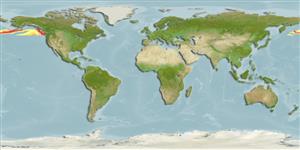Environment: milieu / climate zone / depth range / distribution range
Ecología
marino batipelágico; rango de profundidad 0 - 3290 m (Ref. 50610). Deep-water; 55°N - 48°N
Eastern Pacific: British Columbia in Canada to central Baja California in Mexico.
Tamaño / Peso / Age
Maturity: Lm ? range ? - ? cm
Max length : 21.0 cm TL macho / no sexado; (Ref. 2850)
Short description
Morfología | Morfometría
Espinas dorsales (total): 0; Radios blandos dorsales (total): 8-13; Espinas anales 0; Radios blandos anales: 26 - 33; Vértebra: 82 - 91. Pectorals moderately long and narrow (Ref. 6885). Greenish brown above, silvery on sides and belly showing delicate iridescence (Ref. 6885). Branchiostegal rays: 8 (Ref. 35950).
Occur from near surface to bathypelagic depths. Feed mainly on small fishes but also takes small crustaceans and cephalopods (Ref. 6885). Predators include albacore, salmon, swordfish and lancetfish (Ref. 4525). Oviparous, with planktonic larvae (Ref. 35950).
Life cycle and mating behavior
Madurez | Reproducción | Puesta | Huevos | Fecundidad | Larva
Eschmeyer, W.N., E.S. Herald and H. Hammann, 1983. A field guide to Pacific coast fishes of North America. Boston (MA, USA): Houghton Mifflin Company. xii+336 p. (Ref. 2850)
IUCN Red List Status (Ref. 130435)
Threat to humans
Harmless
Human uses
Más información
Age/SizeCrecimientoLength-weightLength-lengthLength-frequenciesMorfometríaMorfologíaLarvaDinámica larvariaReclutamientoAbundanciaBRUVS
ReferenciasAcuiculturaPerfil de acuiculturaRazasGenéticaElectrophoresesheritabilidadEnfermedadesProcesamientoNutrientsMass conversion
ColaboradoresImágenesStamps, Coins Misc.SonidosCiguateraVelocidadTipo de nataciónSuperficie branquialOtolitosCerebrosVisión
Herramientas
Special reports
Download XML
Fuentes de Internet
Estimates based on models
Preferred temperature (Ref.
123201): 2.6 - 4.7, mean 3.3 °C (based on 21 cells).
Phylogenetic diversity index (Ref.
82804): PD
50 = 0.5000 [Uniqueness, from 0.5 = low to 2.0 = high].
Bayesian length-weight: a=0.00219 (0.00088 - 0.00547), b=3.08 (2.86 - 3.30), in cm total length, based on LWR estimates for this (Sub)family-body shape (Ref.
93245).
Nivel trófico (Ref.
69278): 4.1 ±0.55 se; based on food items.
Generation time: 1.6 ( na - na) years. Estimated as median ln(3)/K based on 1
growth studies.
Resiliencia (Ref.
120179): Medio, población duplicada en un tiempo mínimo de 1.4-4.4 años (Assuming tmax>3).
Fishing Vulnerability (Ref.
59153): Low vulnerability (20 of 100).
